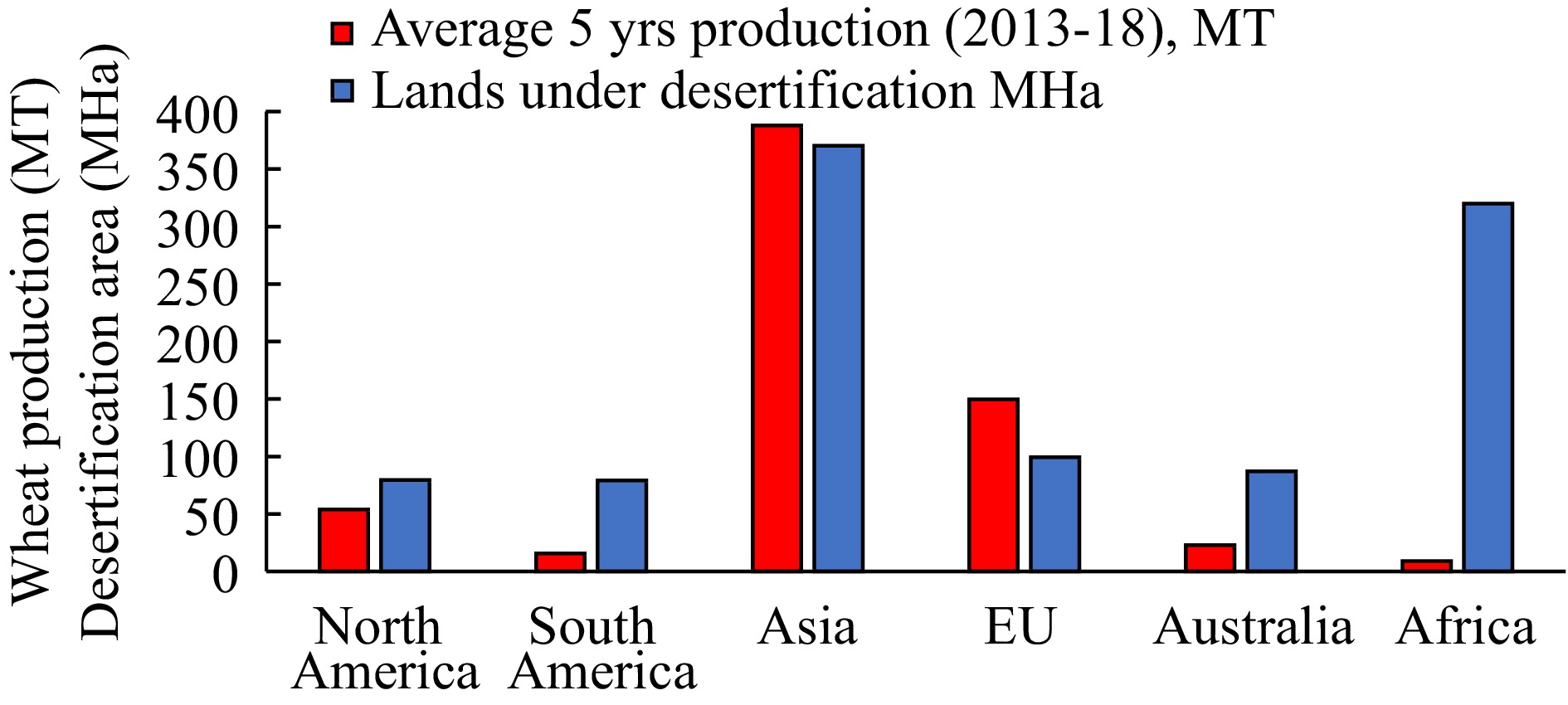-

Figure 1.
Correlation between main wheat producer world areas and extent of soil degradation, according to Agricultural Market Information System (AMIS) 2018 reports and UNEP's 1997 World Atlas of Desertification (2nd Edition).
-
Organism Benefit Source Azospirillum brasilensis Sp. 245 Growth rate. Water stress alleviation (Alvarez, Sueldo, and Barassi 2015) Azospirillum lipoferum Water stress alleviation (Agami, Ghramh, and Hashem 2017) Burkholderia phytofirmans Water use efficiency. Grain yield. Photosynthetic rates (Poupin 2015) Bacillus amyloliquefaciens Temperature stress alleviation (Tiwari et al. 2017) Azospirillum brasilense Sp245 Temperature stress alleviation (Hernaández-esquivel and Castro-mercado 2020) Pseudomonas Putida Temperature stress alleviation (Zulfikar Ali et al. 2011) Pseudomonas fluorescens Salt stress alleviation (Fathalla and El-Mageed 2020) Pantoea agglomerans Temperature stress alleviation (Cherif-Silini et al. 2019) Mycobacterium sp Temperature stress alleviation (Dilfuza Egamberdieva and Phylogeny 2014) Pseudomonas Putida Water stress alleviation (Mahmoudi et al. 2019) Pseudomonas extremorientalis Salinity tolerance (D. Egamberdieva 2011) Pseudomonas chlororaphis Salinity stress alleviation (Mahmoudi et al. 2019) Bacillus pumilus Salinity stress alleviation. Proline accumulation. P solubilization (Ansari, Ahmad, and Pichtel 2019) Hallobacillus sp. SL3 Root length. Dry weight (Ramadoss et al. 2013) Enterobacter asburiae Number of tillers. Grain weight. Growth rates (Kang et al. 2015) Pseudomonas aureantiaca Increased seedling root growth (Dilfuza Egamberdieva 2009) Bacillus safensis Increase in root and shoot biomass, height of plants, yield, as well as increase in chlorophyll content (Chakraborty et al. 2013) Aeromonas hydrophila/caviae (strain MAS-765 Increased the dry matter yield of roots and shoots (Ashraf, Hasnain, and Berge 2004) Bacillus mojavensis Increase in root and shoot weight, chlorophyll content, and nutrient uptake under salt stress (Pourbabaee AA, Bahmani E, Alikhani HA 2016) Lactobacillus plantarum Increased PGPR abundance (Agnolucci et al. 2019) Stenotrophomonas rhizophila Biotic stress resistance (Liu et al. 2021) Curtobacterium flaccumfaciens Growth promotor under drought (Hone et al. 2021) Table 1.
Known PGPR species for wheat.
-
Organism Benefits Source Morchella snyderi Increased root systems, biotic and abiotic stress alleviation (Ridout and Newcombe 2016) Penicillium sp. Abiotic stress alleviation Rhizophagus irregularis Nutrient uptake, growth, and yield (Li et al. 2018) Penicillum expansum Growth promotors trough P solubility in soil (Xiao et al. 2009) Mucor ramosissimus Candida krissii Azospirillum lipoferum Grain yield increase, nitrogen uptake (Gaur 1988) Trichoderma sp. Systemic resistance, mycotoxin suppression, seed germination rate increase (Basinska-Barczak Aneta 2020) (Basinska-Barczak Aneta 2020) (Nawrocka and Małolepsza 2013) Funneliformis mosseae Increased nutrient content, lower free radicals and increased root area under salt stress (Links et al. 2014) Penicillium olivicolor Increased seedling root (Khokhar et al. 2013) Sebacina Vermifera Increased biomass along resistance against biotic and abiotic stresses. (Ray and Craven 2016) Chaetomium sp. Biotic stress alleviation (Blaszczyk, Salamon, and Katarzyna 2021) Gloms etunicatum
Glomus intraradicesIncreased micro and macronutrients uptake in seedlings (Mardukhi et al. 2011) Aspergillus niger Catalase activity, nitrifier (Ripa et al. 2019) Aspergilus flavus Table 2.
Known beneficial fungi species for wheat.
Figures
(1)
Tables
(2)